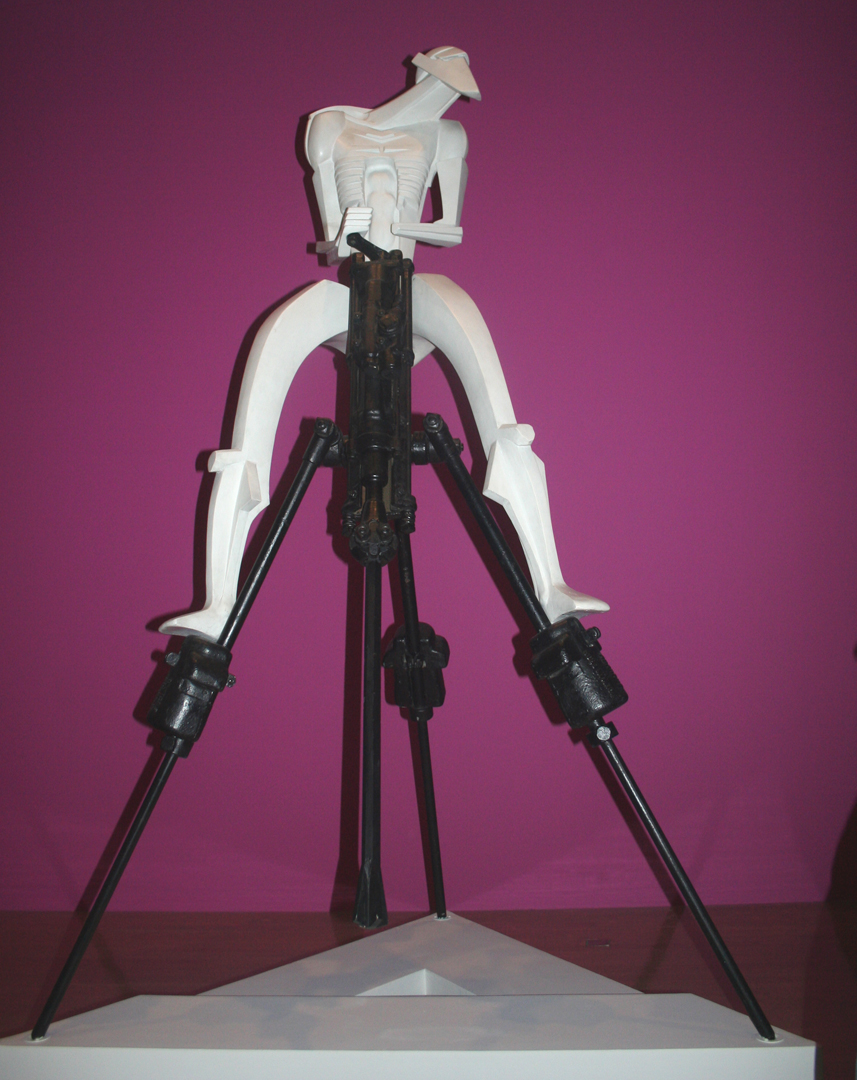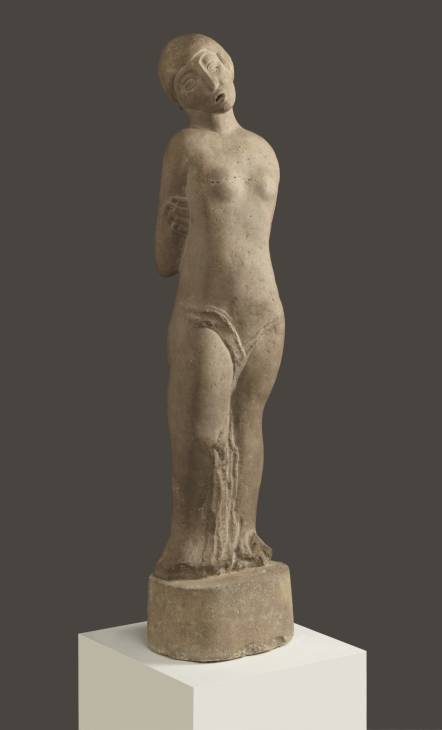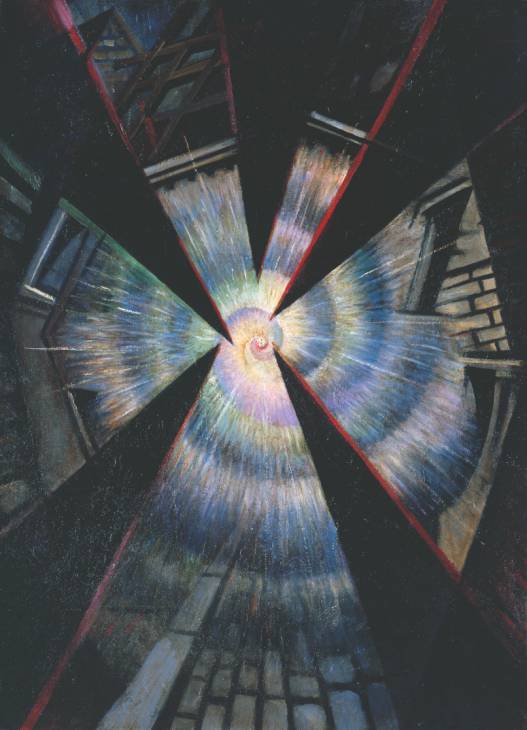The Vorticists at the Tate Britain
Hits: 31903rd August 2011
 The Vorticists were dominated by a two-man sculptural revolution consisting of Jacob Epstein and Henri Gaudier-Brezeska. Both artists were producing important works of modern art in Britain just prior to and during the Great War (1914-18).
The Vorticists were dominated by a two-man sculptural revolution consisting of Jacob Epstein and Henri Gaudier-Brezeska. Both artists were producing important works of modern art in Britain just prior to and during the Great War (1914-18).
Jacob Esptein’s massive The Rock Drill (1912) is a monolithic expression of masculine power. It is the first known sculpture to combine a ready-made object, the drill machine, with a work of art. A robot-like man, made of plaster is straddling the drill, intent on doing some real damage with it. This formidable image prophesises the violent use of machine guns during World War I.
Epstein later dismantled The Rock Drill and sold off the drill. He pared down what was left into a new sculpture, minus parts of the arms, both hands and legs, and recast it. The transformed Torso in Metal from The Rock Drill (1913-14) depicting the shattered and maimed consequences of the military-industrial age on the vulnerable, de-humanized form.
In contrast, his Female Figures in Flenite (1913), which is a name Epstein made up for the green and black stone called serpentine stone, are gestating women bearing reference to Oceanic, Polynesian, and African sculptures. With these pregnant, peaceful, fluid figures, he had dispensed with detail, concentrating on the essential form to produce something modern, yet extraordinarily primitive.
In fact, Epstein’s oeuvre was the expression of all aspects of procreation. For instance, his copulating Doves (1914-1915) carved in Greek marble in the Tate’s collection is a fine example of direct carving, or an almost poetic abstraction from a recognisable source. So too, is the unfinished Maternity (1910) depicting a woman in the later stages of pregnancy.
Epstein also carved the Tomb of Oscar Wilde (1911), a suitably flamboyant Sphinx-like winged creature with overtly displayed genitalia. According to Richard Cork, Epstein’s biographer and the lunchtime lecturer accompanying this exhibition at the Tate’s Clore Gallery, various attempts were made by the officials at the Pere Lachaise cemetery in Paris to censor Wilde’s monument, first with a tarpaulin, and then with strategically placed fig leaves. Legend has it that Aleister Crowley tore off the fig leaves and presented Epstein with them over his lunch table at The Ritz in London.
Jacob Epstein’s method of direct carving was shared by Henri Gaudier-Brezeska, whose versatility in terms of style, subject and materials upstage even Epstein’s heroic efforts. The giant phallic head of the poet Ezra Pound carved in Putney in 1914 looks like it could have fallen from an Easter Island totem.
 But Gaudier-Brezeska’s exquisite smaller sculptures, Singer (1913) (pictured), Crouching Fawn (1913), The Imp (1914), and Red Stone Dancer (1913) made in Derby stone, plaster, alabaster and red Mansfield stone respectively, reflect a veritable genius able to produce the highest-quality work from whatever stone his was given or could find. Sadly, Gaudier-Brezeska was killed in the trenches in 1915 at only twenty-three years of age, after signing up for the French army.
But Gaudier-Brezeska’s exquisite smaller sculptures, Singer (1913) (pictured), Crouching Fawn (1913), The Imp (1914), and Red Stone Dancer (1913) made in Derby stone, plaster, alabaster and red Mansfield stone respectively, reflect a veritable genius able to produce the highest-quality work from whatever stone his was given or could find. Sadly, Gaudier-Brezeska was killed in the trenches in 1915 at only twenty-three years of age, after signing up for the French army.
Despite their dominant influence, Epstein and Gaudier-Brezeska were distancing themselves from Vorticism before the war. However, the initial involvement of the talented American and French sculptors heralded an invasion of British art, which helped kick-start a parallel movement to Cubism and Expressionism.
The Vorticists main protagonist was the English painter Percy Wyndham Lewis, whose gift for self-publicity led him to produce the journal Blast (June 1914). Stamped in bold black letters diagonally across its pink cover, Blast was intended to be explosive and concomitant with the first World War and contained the signed Vorticists Manifesto.
Vorticism embraced poets and dramatists and Blast blessed Shakespeare, Swift and English humour, while blasting fixed grins, Pernod and bad music. Blast published TS Eliot’s seminal poem, Rhapsody on a Windy Night, and a short play by Ezra Pound, who coined the term Vorticist in 1914. Short-lived, like so much of the movement, Blast folded after only two editions, leaving a lasting imprint on graphic design.

The aims and networks of Vorticism have always been complex and difficult to define. Percy Wyndham Lewis described being a Vorticist to a friend like this in 1914, “At the heart of the whirlpool is a great silent place where all the energy is concentrated. And there, at the point of concentration, is the Vorticist.”
Wyndham Lewis is a controversial figure, even more so after writing a book about Hitler in 1931, which misread the murderous intentions of the fascist dictator. However, Lewis’s surviving paintings speak volumes about his ability as an accomplished artist. Compositions (1913), The Dancers and Kermesse (1912) and Arghol (1914) remain sufficiently avant-garde and mind altering to make one see modern environments in new, interesting and interconnecting ways on leaving this exhibition.
Other notable images seen here are Christopher Richard Wynne Nevinson’s charcoal Study for Returning to the Trenches (1914-15) and Bursting Shell (1915) (pictured), both exemplifying the spirit of the time.
 Bursting Shell in oils encapsulates a red and black vortex spiralling out in different directions from an iridescent pink, blue and yellow centre. I have loved this apocalyptic painting for so long and thrilled to see it in “the flesh” here, especially as I have taken a postcard version with me, wherever I go.
Bursting Shell in oils encapsulates a red and black vortex spiralling out in different directions from an iridescent pink, blue and yellow centre. I have loved this apocalyptic painting for so long and thrilled to see it in “the flesh” here, especially as I have taken a postcard version with me, wherever I go.
Alvin Langdon Coburn series of Vortographs (1917) are also worth seeing. Coburn placed a large multi-faceted crystal prism in between his camera and his subject to create beautifully abstracted photographs.
Not to be overlooked amongst this melee of talent is David Bomberg’s predominately red, blue and white painting The Mud Bath (1914), and Edward Wadsworth's wonderful wood cuts of Townscapes (1918) printed in black on thin wove cream coloured Japan paper.
Helen Saunders is one of only two women painters associated with Vorticism. Her warm, fresh colours light up the room, inviting admirers to gather around her paintings, relaxing and chatting.
This collection, which also includes gallery and exhibition programmes, letters and designs from the Rebel Art Centre on Great Ormond Street and the Omega Workshops on Fitzroy Square, bravely re-connect us to a London of almost a hundred years ago, through colour, form, imagery, place and memory. The spirit of the Vorticists is still relevant today and resonant with the continuing struggle of the individual, the eternal and pure nature of art, and the artist within everyone.
The Vorticists at the Tate Britain until 4th September 2011.








